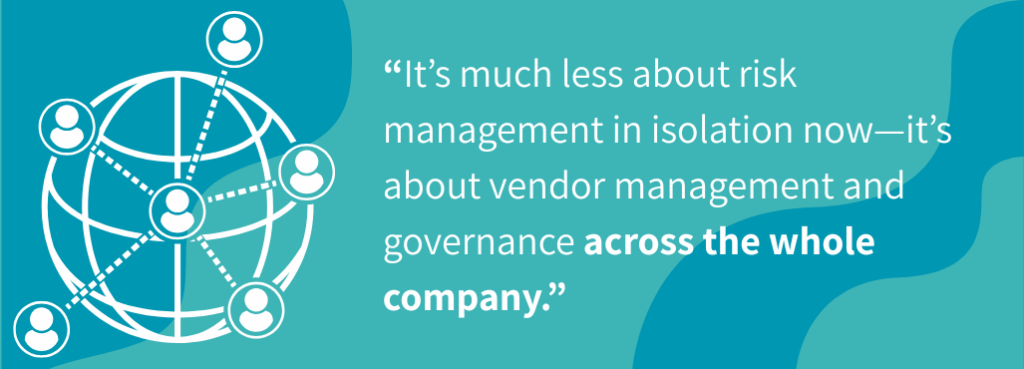Success Story: How a Life Insurance Leader Automated Governance
Last Updated: August 26, 2025
Building a Connected Risk Program: How a Leading Life Insurer Uses LogicManager to Drive Efficiency and Assurance
Since partnering with LogicManager in 2021, this life insurer has expanded their use of the platform to cover corporate governance, HR risk management, third-party risk management, IT governance, and IT security. As their program matured, vendor management became a company-wide priority—not just for IT and security, but for finance and the broader business. To keep pace, they turned to LogicManager to automate reporting, reduce manual effort, and ensure governance processes scaled seamlessly.
Their journey demonstrates how an established organization can use LogicManager to replace manual workarounds with automation that strengthens governance and delivers assurance across every department.
The Problem: Manual Workarounds and Data Risks
The insurer faced challenges that made scaling governance difficult:
- Vendor onboarding: New vendor data was entered in LogicManager but then exported manually to other systems for payment processing. The finance team often had incomplete data or inconsistent formats.
- Reports: Routine reports were running daily, but without dynamic filters or triggers, they often delivered too much noise—or failed to highlight what truly mattered.
- Contracts: Monitoring contract and certificate expirations was reactive. The team wanted proactive visibility into upcoming deadlines without sorting through exports.
- Data accuracy: Entering sensitive fields like banking details created risk of human error. The team needed a more controlled way to capture and link payment codes.
One team member summarized the challenge: “At some point in time they don’t have all the information… they don’t have any controls around data collection.”
The Vision: Automation that Drives Accuracy and Confidence
The team’s vision was clear:
- Automate routine reports so stakeholders got the right data, at the right time.
- Eliminate human error by linking data fields together and using controlled dropdowns.
- Set up logic so contracts approaching expiration were flagged automatically.
Free up risk and compliance staff from clerical work so they could focus on advising leadership.

Turning Vision Into Action with LogicManager
Working with their LogicManager specialist, the team tackled several key initiatives:
1. Automated Vendor Reports
Instead of pushing daily static reports, the team used computed columns and parameters inside LogicManager to dynamically filter data—for example, only showing vendors created today, or only showing records relevant to a specific payment cycle.
“If I could run a report for vendors created as of today… it would make the process so much cleaner,” a risk officer explained.
LogicManager’s built-in assistant (LMX) guided them through building these computed fields, showing how filters could be tied directly to “today’s date” or other parameters.
2. Proactive Contract Oversight
To avoid missed deadlines, the team configured LogicManager to automatically flag contracts nearing expiration. Using formulas in computed columns, they created fields such as “Expiring in 30 days” or “Expiring in 60 days” and set filters to trigger scheduled reports.
“We want a report to be sent whenever the contracts are nearing expiration,” one team member said. “If I can run this monthly and it’s blank, that’s fine. But if anything is expiring soon, we’ll see it immediately.”
3. Reducing Payment Errors with Taxonomy Rules
To strengthen financial accuracy, the company introduced structured fields for bank codes, branch names, and branch codes. Rather than relying on open text fields (prone to spelling errors), they worked toward linking dropdown fields together, ensuring that once a bank was chosen, only valid branch codes would be selectable.
While building hundreds of visibility rules manually would be tedious, LogicManager’s data load and configuration capabilities offered a scalable path forward.
“What’s important is being able to accurately capture payment information while minimizing typing errors,” the data security officer explained.
4. Exploring Workflow Integration
The team also began re-engaging a DocuSign integration, with the goal of pushing contracts through LogicManager workflows for digital signature and seamless onboarding.
Results: Automation, Accuracy, and Alignment
By redesigning these processes in LogicManager, the insurer has already seen tangible benefits:
- Automation: Reports no longer require manual manipulation—computed fields and parameters ensure only the right data gets delivered.
- Proactivity: Contracts and certificates approaching expiration are surfaced automatically, reducing the risk of lapses.
- Accuracy: Payment data entry is structured and controlled, minimizing errors.
- Scalability: What began as IT and security-driven oversight is now a company-wide governance program.
Leading the Way in Governance
Throughout this process, the insurer demonstrated how to approach governance challenges with creativity and boldness. Rather than accept the limitations of static reports or manual oversight, they leveraged LogicManager to:
- Build dynamic, automated reports aligned to business needs.
- Extend governance beyond risk management into finance, contracts, and HR.
- Reimagine how data fields and workflows can be linked for accuracy and assurance.
Advice for Other Organizations
This team’s journey highlights three critical lessons for peers:
- Automate where possible: Use computed fields, filters, and parameters to let the system do the work.
- Think holistically: Governance isn’t just about risk—it spans payments, vendors, contracts, and IT.
- Design for assurance: Build rules and dropdowns that prevent errors, not just catch them.
By investing in automation and connected governance, this insurer has positioned itself not only to save time, but to deliver the one thing leadership values most: certainty.
